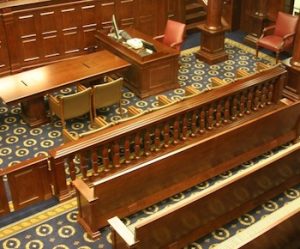 Organik Kimya AS v. Rohm & Haas Co., Nos. 2015-1983, 2015-2001, 2017 (Fed. Cir. Oct. 11, 2017) (Before Prost, C.J., Newman, and Taranto, J.) (Opinion for the court, Newman, J.)
Organik Kimya AS v. Rohm & Haas Co., Nos. 2015-1983, 2015-2001, 2017 (Fed. Cir. Oct. 11, 2017) (Before Prost, C.J., Newman, and Taranto, J.) (Opinion for the court, Newman, J.)
Organik Kimya AS (“Organik”) appeals the decisions of the Patent Trial and Appeal Board (“Board”) in two related inter partes review (“IPR”) proceedings for which Organik is the Petitioner. The Patent Owner is Rohm & Haas Co. The Board sustained the patentability of the challenged claims, Organik appeals.
The challenged patents are directed to processes for preparing certain emulsion polymers having improved opacity – as used in opaque coatings such as paints, coatings, inks, and other products benefitting from opacity.
On appeal, Organik challenges the Board’s claim construction and application of the construction to the alleged prior art references.
The Court reviews the Board’s claim construction de novo because “the [Board] relied principally on the intrinsic evidence of the patent specification and the prosecution history.” See Microsoft Corp. v. Proxyconn, Inc., 789 F.3d 1292, 1297 (Fed. Cir. 2015). Any Board “findings based on extrinsic evidence, such as expert testimony and documents not previously of record, are reviewed for support by substantial evidence in the record before the [Board].” Id. Anticipation is a question of fact; findings of a PTO tribunal are reviewed for support by substantial evidence in the record before the PTO. Kennametal, Inc. v. Ingersoll Cutting Tool Co., 780 F.3d 1376, 1381 (Fed. Cir. 2015). Obviousness is a matter of law and receives plenary review on appeal, with any underlying findings of fact reviewed for support by substantial evidence in the PTO record. Id.
First, Organik argued that the Board adopted an overly narrow interpretation of the “swelling agent” term and improperly added an additional step to the claims. However, the specification described the factors that supported the Board’s claim construction, including the alleged “additional” step. Additionally, Rohm and Haas presented expert testimony to the Board that the “swelling agent” term was defined in the specification in accordance with the ultimate claim construction. The Court stated: “[t]here was no evidence to contravene either the patent specification or the expert testimony.” Therefore, the Court held that the Board’s claim construction was not in error.
Next, Rohm and Haas supported its contention that the challenged patents were not anticipated or obvious, in light of the cited prior art reference, by providing expert testimony and experiments. Rohm and Haas’s expert testimony and experimental verification was presented without contradictory evidence by Organik. Instead, Organik sought to criticize Rohm and Haas’s expert’s evidence as inadequate, by challenging his methodology and arguing that the evidence was “irrelevant.” Nonetheless, the Board observed:
“[Organik’s expert] has not provided experimental data demonstrating that a different manner …. would have provided results that differ from those observed in [Rohm and Haas’s expert] replications. Nor has [Organik] provided any experimental data or evidence establishing that the process of [the prior art reference] inherently disclosed a “swelling agent,” as required by [the challenged claims.”
In response to the Board’s finding, Organik argued on appeal that it was error for the Board to require Organik to conduct experiments to support its argument of inherency. However, the Court held that “… the issue is not whether experiments by Organik were required, but whether Organik provided sufficient evidence and argument to negate and outweigh the evidence and argument provided by Rohm and Haas.” The Court held that the Board “correctly held that [Rohm and Haas’s expert’s] experimental evidence outweighed the unsupported criticism of [the expert’s] methodology.” Therefore, the Court affirmed the Board’s decision that the challenged claims were not anticipated or rendered obvious by the cited prior art references.
When confronted with expert experiments and testimony, practitioners must provide sufficient evidence and argument to negate and outweigh the testimony – unsupported critiques of the expert’s methodology and challenges of relevance are insufficient.
[Troutman-Ad]
[Troutman-About]

![[IPWatchdog Logo]](https://ipwatchdog.com/wp-content/themes/IPWatchdog%20-%202023/assets/images/temp/logo-small@2x.png)


![[Advertisement]](https://ipwatchdog.com/wp-content/uploads/2024/05/Quartz-IP-May-9-2024-sidebar-700x500-1.jpg)
![[Advertisement]](https://ipwatchdog.com/wp-content/uploads/2024/04/Patent-Litigation-Masters-2024-sidebar-last-chance-700x500-1.jpg)

![[Advertisement]](https://ipwatchdog.com/wp-content/uploads/2021/12/WEBINAR-336-x-280-px.png)
![[Advertisement]](https://ipwatchdog.com/wp-content/uploads/2021/12/2021-Patent-Practice-on-Demand-recorded-Feb-2021-336-x-280.jpg)
![[Advertisement]](https://ipwatchdog.com/wp-content/uploads/2021/12/Ad-4-The-Invent-Patent-System™.png)






Join the Discussion
No comments yet.